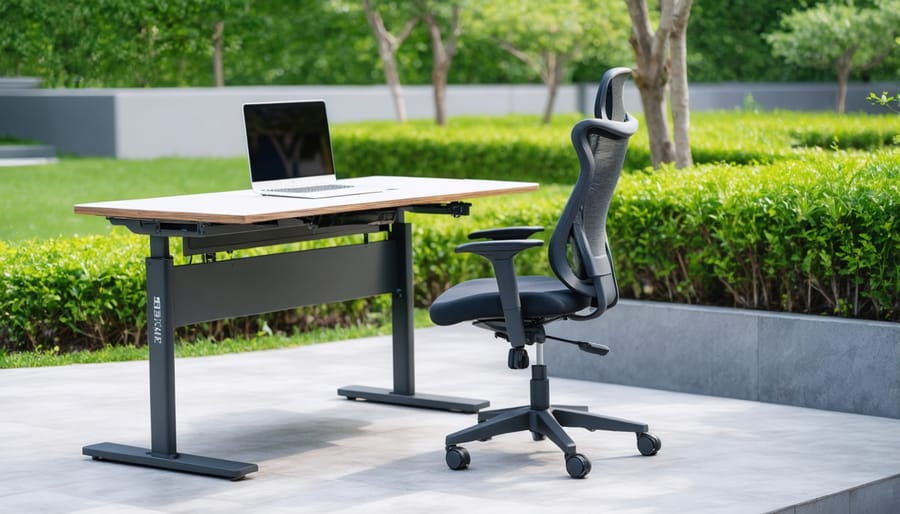Transform Your Backyard Office: Ergonomic Design That Actually Works

Transform your workspace into an ergonomic haven by implementing proven design principles that boost both comfort and productivity. Start with proper monitor positioning – elevate screens to eye level and maintain an arm’s length distance to prevent neck strain. Invest in adjustable furniture that supports natural posture, including chairs with lumbar support and height-adjustable desks that allow seamless transitions between sitting and standing. For outdoor workspace protection, incorporate weather-resistant materials and adjustable shade solutions while maintaining these core ergonomic principles.
Focus on creating zones that minimize repetitive reaching and twisting motions – position frequently used items within easy arm’s reach and arrange work surfaces to support neutral wrist positions during typing and mouse use. These foundational ergonomic design elements not only prevent discomfort and potential injuries but also create an environment that naturally encourages healthy working habits and sustained productivity throughout the day.
Natural Light and Visual Comfort
Strategic Positioning
Strategic positioning of your workspace relative to natural light can significantly impact your comfort and productivity. When setting up your outdoor workspace, orient your desk or work surface perpendicular to the sun’s path to minimize direct glare on your screen. Position yourself so that sunlight comes from the side, ideally your non-dominant side, to reduce shadows when writing or working.
Consider installing adjustable shade solutions like retractable awnings or pergolas to control light exposure throughout the day. Morning sun from the east can be energizing, while afternoon western sun tends to be more intense and potentially disruptive. If possible, choose a location with some natural overhead coverage, such as tree canopy, to create a dappled light effect that’s easier on the eyes.
For year-round comfort, account for seasonal changes in the sun’s position. What works in summer might need adjustment in winter months when the sun sits lower in the sky.

Glare Management Solutions
Managing glare in outdoor workspaces requires a thoughtful combination of natural and artificial solutions. Start by positioning your workspace perpendicular to windows or bright light sources to minimize direct glare on screens. Installing adjustable window treatments, such as outdoor blinds or retractable awnings, gives you control over natural light throughout the day.
Consider adding anti-glare screens to your devices and using matte screen protectors to reduce reflections. Strategic placement of plants or decorative screens can create natural shade without completely blocking light. For permanent solutions, install light-diffusing panels or UV-resistant window films that maintain visibility while reducing harsh glare.
Keep your workspace flexible by using mobile furniture that can be repositioned as the sun moves throughout the day. Light-colored surfaces should be balanced with darker elements to prevent excessive reflection, while anti-glare lighting fixtures can provide supplemental illumination when needed. These simple adjustments can significantly improve visual comfort and productivity in your outdoor workspace.
Temperature and Environmental Control

Shade Solutions
Creating a comfortable outdoor workspace starts with effective shade solutions to protect you from harsh sunlight and maintain optimal viewing conditions for your screens. Retractable awnings offer a flexible option that can be adjusted throughout the day as the sun moves, providing targeted shade exactly when and where you need it. These can be manually operated or motorized for added convenience.
Pergolas present a more permanent solution while adding architectural interest to your outdoor space. Consider installing weather-resistant fabric panels or retractable canopies between the pergola slats for customizable shade coverage. For a natural approach, train climbing plants like wisteria or grape vines to create a living canopy that provides shade during summer months while allowing more light during winter when leaves fall.
Umbrellas offer portable shade solutions that can be repositioned as needed, while shade sails provide a modern aesthetic and can be configured in various shapes to cover larger areas. When selecting your shade solution, consider factors like wind resistance, UV protection rating, and how the material will hold up against weather conditions in your climate.
Ventilation Strategies
Proper ventilation is crucial for maintaining a comfortable and productive outdoor workspace. Start by positioning your workspace to take advantage of natural airflow patterns, ideally with openings on opposite sides to create cross-ventilation. Consider installing adjustable vents or windows that can be opened or closed depending on weather conditions.
For temperature control, combine passive and active ventilation methods. Use awnings or pergolas to provide shade while allowing air movement, and consider installing ceiling fans for additional air circulation on still days. In enclosed spaces, solar-powered exhaust fans can help remove hot air while drawing in cooler air from below.
During warmer months, position portable fans strategically to create cooling airflow without causing papers to scatter. For colder seasons, ensure your ventilation system can be partially closed while still maintaining healthy air exchange. Remember to keep air vents clear of storage items and regularly clean any screens or filters to maintain optimal airflow.
A well-ventilated workspace not only enhances comfort but also helps protect your equipment and materials from moisture and temperature fluctuations, contributing to a more sustainable and enjoyable outdoor working environment.
Ergonomic Furniture Selection

Seating Considerations
When selecting outdoor seating for your ergonomic workspace, durability and comfort must go hand in hand. Look for chairs made from weather-resistant materials like powder-coated aluminum, resin wicker, or marine-grade polymer that can withstand sun, rain, and temperature changes. The seat height should be adjustable to maintain proper posture, with your feet flat on the ground and thighs parallel to the floor.
Choose chairs with waterproof cushions featuring quick-dry foam and mildew-resistant fabrics. The backrest should provide adequate lumbar support and ideally be adjustable to maintain a natural spine alignment. Armrests are essential for reducing shoulder strain, but ensure they’re properly positioned to support your elbows while typing.
Consider chairs with breathable mesh backs to promote airflow during warm weather. The seat pan should be wide enough to accommodate comfortable movement and deep enough to support your thighs without pressing against the back of your knees.
For added convenience, select chairs with smooth-rolling casters suitable for outdoor surfaces. Some models come with locking mechanisms to prevent unwanted movement on uneven ground. Remember to store your chair in a covered area or use a weather-resistant cover when not in use to extend its lifespan.
Work Surface Design
A well-designed work surface is fundamental to creating an ergonomic workspace that promotes comfort and productivity. The ideal desk height should position your forearms parallel to the ground when typing, typically between 28 to 30 inches for most adults. Consider adjustable-height desks that allow you to customize the working position and even alternate between sitting and standing throughout the day.
The material of your work surface matters significantly. Choose materials that are smooth, non-reflective, and maintain a comfortable temperature. Solid wood or high-quality laminate surfaces offer durability while providing a comfortable writing and typing experience. Avoid glossy finishes that can create glare and cause eye strain.
Your work surface should be deep enough to accommodate your monitor at arm’s length (typically 20-28 inches) while leaving space for your keyboard and mouse. The width should allow for comfortable arm movement without feeling cramped. A minimum width of 30 inches is recommended, though 48-60 inches is ideal if space permits.
Include rounded edges to prevent pressure points on your wrists and forearms. Consider installing a cable management system to keep wires organized and prevent them from cluttering your workspace.
Storage and Accessibility
Weather-Protected Storage
Protecting your equipment from the elements is crucial for maintaining a functional outdoor workspace. Implementing proper all-weather protection strategies ensures your tools and materials remain in optimal condition year-round.
Start by choosing storage solutions with proper ventilation to prevent moisture buildup while keeping rain and snow out. Consider installing adjustable shelving systems that keep items off the ground and organize them by frequency of use. Weather stripping around doors and windows prevents dust and moisture from seeping in, while dehumidifiers can help control indoor climate during humid seasons.
For sensitive equipment, incorporate moisture-absorbing materials like silica gel packets or use airtight containers with rubber seals. Position your storage unit on slightly elevated ground or a concrete pad to prevent water damage from ground contact. Install proper drainage systems around the storage area to direct water away from the foundation.
Remember to regularly inspect seals, hinges, and weather stripping for wear and tear, replacing them as needed to maintain optimal protection for your stored items.
Workspace Organization
A well-organized outdoor workspace is essential for maintaining productivity and comfort. Start by positioning your desk perpendicular to direct sunlight to minimize glare while still enjoying natural light. Create distinct zones for different activities – a primary work area, a storage space for equipment, and a relaxation corner for breaks.
Keep frequently used items within arm’s reach to minimize unnecessary stretching or twisting. Organize cables and tech equipment in weatherproof storage solutions, ensuring they’re protected from the elements while remaining easily accessible. Consider using mobile storage units that can be quickly moved indoors during inclement weather.
Maximize vertical space with wall-mounted shelving or pegboards for tools and supplies. Implement a clear desk policy by storing non-essential items in weather-resistant cabinets or boxes. For comfort and flexibility, arrange your seating area to allow easy movement between different work positions throughout the day.
Remember to leave adequate clearance around furniture for comfortable navigation and proper air circulation. This thoughtful organization not only enhances productivity but also creates a more enjoyable outdoor working environment.
Creating an ergonomic outdoor workspace isn’t just about following a checklist – it’s about crafting a comfortable, productive environment that works for you. By implementing these ergonomic design principles, you’ll transform your outdoor area into a space that supports both your well-being and work efficiency. Remember to start with proper seating and work surface heights, ensure adequate lighting while managing glare, and maintain comfortable temperature levels throughout your workday.
Take small steps to incorporate these changes gradually, and pay attention to how your body responds. Listen to any discomfort signals and adjust accordingly. The beauty of outdoor workspace design lies in its flexibility – you can continuously modify and improve your setup as seasons change and your needs evolve.
Consider documenting your ergonomic improvements and their effects on your productivity and comfort. This will help you fine-tune your space over time. With thoughtful implementation of these principles, you’ll create an outdoor workspace that not only looks inviting but also supports your health and enhances your work experience for years to come.

